 Progress City has ground to a standstill over the last several weeks as I’ve traipsed up and down the eastern seaboard on various adventures. The true Disney scholar, however, is never off duty, and I was thankfully able to get my Disneyana fix on several occasions during a week-long stay in New York City.
Progress City has ground to a standstill over the last several weeks as I’ve traipsed up and down the eastern seaboard on various adventures. The true Disney scholar, however, is never off duty, and I was thankfully able to get my Disneyana fix on several occasions during a week-long stay in New York City.

Our first encounter was at the Children’s Museum of Manhattan, which is hosting a traveling exhibition of illustration art to celebrate the recent 65th anniversary of the Little Golden Books series. The exhibit featured the work of several artists with Disney ties, most notably Swedish illustrator Gustaf Tenggren and Disney legend Mary Blair.
Unfortunately, despite the fact that the only posted prohibition was on the use of camera flashes, someone swooped down on my camera and I and put the nix on my photography before I could get any good pictures of the amazing Tenggren artwork or the whimsical Blair pieces.
The exhibit was small but fascinating; a variety of artists were represented and many of their most famous works were covered. Personally, I had no idea that Tenggren had illustrated the best-selling Poky Little Puppy.
Another museum, another Disney encounter: MoMA is hosting an exhibition of art and media by renowned surrealist Salvador Dalí. Dalí: Painting and Film, which runs until September 15th, covers the entire span of Dalí’s career, but of interest to us is a very unique period in 1945-46 when Dalí found himself in California working for Walt Disney. Thankfully, MoMA devoted an entire section of the exhibit to their collaboration, Destino.
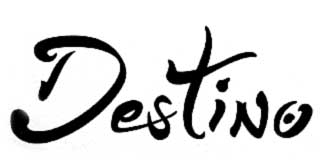
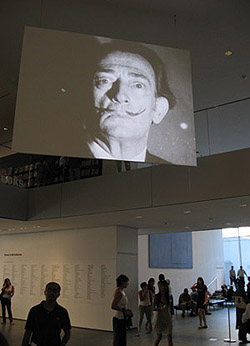 Dalí was an unconventional talent, to say the least, and many might be surprised to find that he had ties to the Disney Studios. Yet Dalí was an avid fan of Disney’s films and, after meeting at a party at Jack Warner’s house, Dalí came to the studio to work on Destino.
Dalí was an unconventional talent, to say the least, and many might be surprised to find that he had ties to the Disney Studios. Yet Dalí was an avid fan of Disney’s films and, after meeting at a party at Jack Warner’s house, Dalí came to the studio to work on Destino.
Dalí spent eight months at the studio, working with artist John Hench on storyboards and concepts for various sequences. According to Hench, Dalí would come up with the idea for a sequence or one of his trademark visual matches and it was up to Hench to help link those scenes within the larger work so that the transition between sequences would not be too jarring.
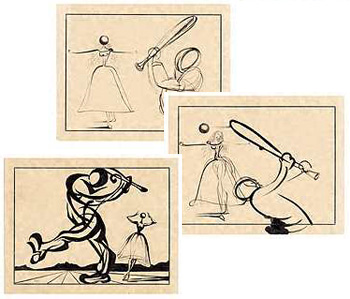 Storyboard sketches for the baseball sequence
Storyboard sketches for the baseball sequence Eventually a tale emerged of love lost and found, with many of Dalí’s trademark images in place and featuring a ballet that used baseball as a metaphor for love. Disney’s plan was to pair the animation with vocalist Dora Luz’s performance of Armando Dominguez’s Spanish-language ballad Destino for inclusion in a future package feature along the lines of Make Mine Music or Melody Time.
Eventually a tale emerged of love lost and found, with many of Dalí’s trademark images in place and featuring a ballet that used baseball as a metaphor for love. Disney’s plan was to pair the animation with vocalist Dora Luz’s performance of Armando Dominguez’s Spanish-language ballad Destino for inclusion in a future package feature along the lines of Make Mine Music or Melody Time.
Sadly, the Disney Studios was suffering financially both during and immediately after World War II, and the package features were no longer profitable or desirable. By 1950, Disney would return to narrative features with Cinderella; there was neither money nor need for Destino. Hench tried to convince Walt to continue funding the project; 15 seconds of animation were completed to try and pique Walt’s interest. While Walt was still intrigued by the project, the money wasn’t there and so Walt canceled production. According to Hench, in later years Walt would regret that they had abandoned the short. Yet Destino remained unfinished, and most animation scholars assumed that it was lost for all time.
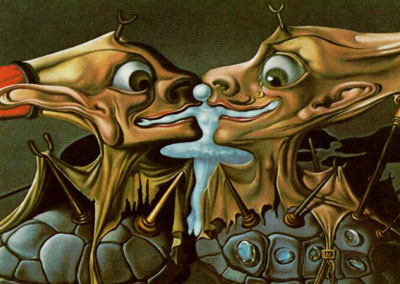 A still from the fifteen seconds of animation completed for Destino in 1946
A still from the fifteen seconds of animation completed for Destino in 1946Years passed. In 1999 while working on Fantasia 2000, Roy E. Disney began to consider the possibility of completing Destino. Allegedly working in part behind the back of Disney’s then-CEO Michael Eisner, Roy Disney delegated the project to French animator Dominique Monfrey and the animation staff of Disney Studios France. With the intent of including the short in another Fantasia sequel, animators began to piece together Dalí’s notes and storyboards. John Hench, still working with Disney fifty-odd years later, was able to help interpret the notes and explain Dalí’s visual metaphors. When plans for Fantasia 2006 fell through, it was decided to release Destino as a short. The film finally premiered at the Annecy International Animated Film Festival in the summer of 2003 – 58 years after it was greenlit.
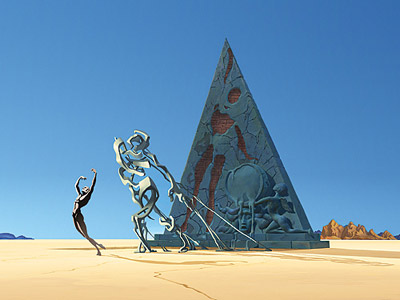 Still from the completed Destino
Still from the completed DestinoWhile Dalí’s art was impressive, I found the highlight of the exhibit to be the completed Destino itself, which aired continuously on one of the walls of the gallery. I’ve wanted to see the short for five years now to no avail, so the MoMA gallery was a fantastic setting and occasion to finally sit and watch it.
The short was worthy of the acclaim it has garnered since its release; its animation manages to be both modern and classical at the same time, and although I quibble slightly with the decision to incorporate computer animation I feel that it was as effectively done as possible. The character animation is intriguing, as it tries to find a medium ground between Disney and Dalí’s styles – the result is vaguely reminiscent of Aeon Flux. I’ll admit that I’m an easy audience – I got chills at the simple title card, which consisted merely of Dalí and Disney’s trademark signatures side by side. All in all, a good day at the museum.
From culture to commerce – our last stop on our New York tour:
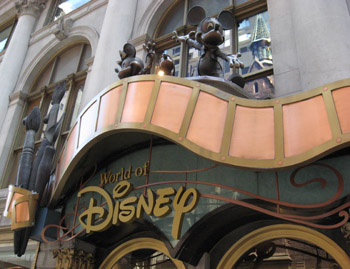
This place is surreal. You go straight from midtown Manhattan into some Disney marketing fever-dream, and before long you feel you’re right on the shores of Lake Buena Vista. Sitting on Fifth Avenue near its intersection with 55th Street, the World of Disney has three floors of Disney merchandise divided into various departments. The selection isn’t too much different from what used to be found at the typical Disney Store, and sadly their selection of new Walt Disney World merchandise was nonexistent. It was nice to soak up the atmosphere a bit, though, and there was a selection of NYC-specific Disney merchandise.
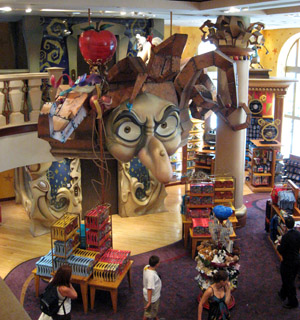 Scary.
Scary.As the book and video selection wasn’t as fleshed out as I’d like, the highlight for me was the Art of Disney gallery on the third floor. The typical selection of figurines and fine art was present, and although their in-stock poster selection was disappointing they did have one of the “print on demand” kiosks. Having not seen one of these in action before, I was a little too excited at the variety of old attraction posters they’ve made available via this service. This won’t be good news for future paychecks. They also had these amusing fine-art pieces on show, which I hadn’t seen before:
The store was a nice slice of Disneyana and they even had a room where kids could get their pictures taken with costumed characters. Donald was walking around in his NYFD uniform, which was a little weird, but whatever.
So that’s it – New York City for the Disney obsessive. As I said to Teddi when we were having Bastille Day dinner in a French restaurant, “this is almost just like being in the real EPCOT!” She tolerates me – it’s cute.
Till next time…
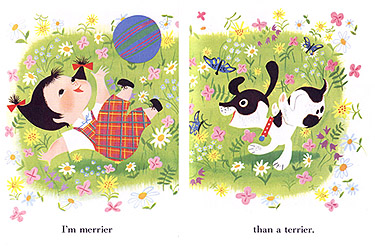

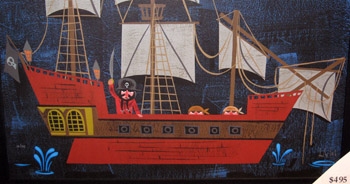









[…] doing a little bit of fact-checking for my recent spiel about the 2003 Disney short Destino, I found that it was suddenly and mysteriously absent from […]
Nice post. I went to the exhibit while it was in Los Angeles, went back for a 2nd visit. I have seen the destino collection in person and sold one of the drawings about 7 years ago. Hard to find anyting from the Destino collection these days.
Everyone should see the film Spellbound. The dream sequece really did make the film.
Thanks for the comments! It was a great exhibit; while I obviously focused here on Destino, there was a lot of amazing material from throughout his career. I was fascinated by all the work he had done for the Marx Brothers film he wanted to make – pity we’ll never see that!
You’re right about Spellbound… I wonder if that film would be remembered at all if not for the dream sequence. They had that playing on a giant wall at MoMA and it was great to see. It’s definitely the high point of the film, which is slightly ridiculous otherwise (the psychology involved is only slightly short of witch-doctory!).